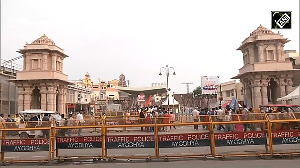Last week, Hong Kong and Shanghai Banking Corporation bought CDC Capital Partners' (earlier Commonwealth Development Corporation) 14.71 per cent stake in UTI Bank.
The agreement includes an option to buy CDC's balance 5.37 per cent stake in the bank over the next three months, taking HSBC's stake in UTI Bank to over 20 per cent.
Further, the multinational bank has made an open offer to buy another 20 per cent stake in UTI Bank.
Although the open offer is more to meet the regulatory requirements and HSBC is not too keen to pick up 40 per cent stake in UTI Bank (the fact that the open offer is priced at Rs 90 when the ruling price of UTI Bank is around Rs 120 testifies that), the move has shaken the Indian banking industry out of its stupor.
Industry observers have started making noise about the predators and the target banks, and that the prices of most of the private sector banks -- both old and new -- are moving southwards on bourses.
At least some of them can be picked up by other foreign banks who are keen on strengthening their foothold in the emerging Indian market. The normally coy banks too are acting smart; they feel that they can extract a higher price from strategic or financial investors for their stakes.
So, it seems that the Indian banking industry is ready for consolidation and HSBC's action is a prelude to a plethora of mergers and acquisitions.
But is it really so? Will the Citis and ABN Amros now go cherry-picking in the Indian banking universe without losing time? And the Chrysalises and NewBridge Capitals of the world start picking up stakes in private banks in right earnest?
Let's take a look at the universe of old private sector banks, some of which are possible targets for acquisition. Broadly, they can be categorised into three groups.
In the first group, there are three banks -- Karur Vysya Bank, Federal Bank and City Union Bank. All three have good assets, good distribution channel (read branches), reasonably modern technology platforms and competent management.
In the second group, there are Karnataka Bank, South Indian Bank, Laxmi Vilas Bank, Bank of Rajasthan and Tamilnad Mercantile Bank.
These banks have good distribution channel and the quality of their assets is possibly acceptable to any acquirer. However, they lag behind on the technology front. Except for Tamilnad Mercantile Bank, governance is also not an issue with this group.
Lord Krishna Bank, Catholic Syrian Bank, Dhanalakshmi Bank, United Western Bank, Sangli Bank and Ganesh Bank of Kurundwad belong to the third group.
This group cannot boast of quality assets and good governance. Also, Catholic Syrian Bank, Sangli Bank and Ganesh Bank of Kurundwad are not listed on bourses.
A common thread that runs through all these banks is their high cost of operations. This is because they lend to small businesses and hence the transaction costs are very high.
The promoters are not too keen in the growth of business because they do not want to lose control over the banks.
To build a big asset portfolio, a bank needs higher capital and the promoters of the old private banks are not willing to pump in fresh money. At the same time, they are not willing to bring in fresh capital from outside for fear of losing their hold over the bank.
The other common attributes of these banks are: they are low on technology and high on staff strength. Besides, the employees are unionised.
If these imponderables are not enough, another factor can prove to be a stumbling block for a prospective acquirer. Some of the old private banks are controlled by certain communities.
For instance, the Nadar community holds about 80 per cent stake in Tamilnad Mercantile Bank; the coastal-based Brahmins of Mangalore control Karnatak Bank; the Vysyas from Tamil Nadu have considerable say in Karur Vysya Bank and Laxmi Vilas Bank; and the Syrian Catholic community dominate Catholic Syrian Bank.
In the face of stiff resistance put up by the Syrian Catholic community, the Chawlas of Bangkok took years to transfer their stake in Catholic Syrian Bank.
So, the message is quite clear: before making any move, the prospective acquirer needs to take the community (which controls the bank) into confidence.
But even this may not clear the road blocks. To complicate matters further, the promoters' holding in most of these banks is minuscule. They have a fragmented, widespread ownership.
For instance, the promoters' stake in Karur Vysya Bank is 4.43 per cent, in Laxmi Vilas Bank 1.77 per cent and it's almost non-existent in Karnataka Bank.
So, anybody who wants to pick up one of these banks has no choice but to make a hostile bid by making an open offer. To do this, the acquirer needs the full backing of the regulator -- the Reserve Bank of India (RBI).
If the offer generates enough response and the entity manages to takeover the bank with RBI's backing, at the second stage it needs to spend a lot of money to cut the flab by offering a voluntary retirement scheme (VRS) to employees and build a compatible technology platform.
At a parallel level, it also needs to retrain the existing staff. The bottomline is: one needs to carry a big money bag to acquire any of these banks.
Over the past few years, three old private sector banks have been taken over by stronger peers.
Out of the three, two were forced mergers. Punjab National Bank took over Nedungadi Bank and Bank of Baroda took over State Bank of Benaras last year.
Both mergers were pushed by RBI to rescue two private banks that were mismanaged and had bulging non-performing assets. The third private bank -- Bank of Madura -- was gobbled up by ICICI Bank through a share-swap route.
Through this merger, ICICI Bank added 1.2 million customer accounts to its book and 263 branches to its branch network.
This gave ICICI Bank the required critical mass in the run up for ICICI's merger with the bank to give birth to the country's first universal bank. By merging Bank of Madura with itself, ICICI Bank bought at least two years of growth at one stroke.
Foreign banks may not have the compulsion of ICICI Bank. They may also set their eyes on new generation private sector banks that are a different kettle of fish.
These banks have a reasonably well spread out distribution network and modern technology platform. But the catch here is: the sellers are possibly more eager than the prospective buyers.
They are keen to place strategic stakes with a multinational bank or a private equity fund because they have been looking for capital, expertise and new technology.
Sensing their earnestness, the prospective strategic partners may not give them the price that the promoters have been looking for. CDC made a killing (over Rs 250 crore (Rs billion)) by selling its stake in UTI Bank to HSBC but every bank is not UTI Bank.
The compounded annual growth rate (CAGR) of UTI Bank's net profit of the past five years has been 50 per cent and that of assets is around 35 per cent. This has not been the case with every new generation private bank.
Two of the new banks that opened shop in the mid-1990s -- HDFC Bank and ICICI Bank -- have done remarkably well setting new standards for the sedate Indian banking industry.
Among others, IDBI Bank and UTI Bank have shown solidity in operations even though they lagged behind the leaders in growth parameters. But the rest of the pack has not done much to claim credit.
Centurion Bank is being restructured by Rana Talwar-led Sabre Capital, BankMuscat and a clutch of investors after its original promoter made a mess.
Global Trust is trying hard to come out of the shadows of Ketan Parekh after cleaning its balance sheet by making huge provisions -- a price for its misadventure in the 2001 stock market boom.
Both IndusInd Bank and Bank of Punjab are ready with open arms to woo strategic investors as they want to reinvent themselves in the changing matrix.
In February last year, the government raised the foreign ownership in Indian private sector banks through the foreign direct investment route to 49 per cent.
The first and only multinational bank to acquire an Indian private bank is ING, which in September last year, raised its stake from 20 per cent to 44 per cent in the Bangalore-based Vysya Bank and took over the management control. It took more than a year for HSBC to make another attempt to get a toe-hold in another Indian private bank.
Will HSBC be able to take over the management control in UTI Bank emulating the ING example? It won't be an easy task as UTI Bank is very different from Vysya Bank. Three institutional shareholders -- UTI, LIC and GIC -- collectively hold over 54 per cent stake.
They represent the government. Despite holding over 32 per cent stake in ITC, BAT Plc has not been able to push its case because Indian financial institutions hold about 36 per cent stake in ITC.
With a much higher stake, the trio of UTI, LIC and GIC can dictate the terms in UTI Bank and reduce HSBC into a BAT if the government chooses so.
For record's sake, the UTI Bank deal will hold the key to the consolidation drive in Indian banking industry. But ultimately the buck stops at the government.







 © 2025
© 2025